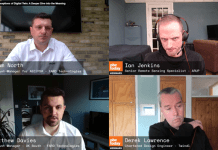Openness, collaboration, and interoperability need to be embraced to optimise the implementation of digital twin technology, according to research by Asite
The research reveals that 75% of companies from various industries across six countries have already implemented or plan to implement a digital twin within a year.
Digital twins are set to usher in a new and exciting digital era, with retail, manufacturing, and housing set to reap its benefits, Asite explores the foundations required for a digital twin, specifically focusing on the Golden Thread of information.
Responding to the integral role digital twins are set to play in ushering in an almost prescient digital era, the report, entitled ‘Digital Twins: Weaving the Golden Thread,’ focuses on the idea of the golden thread of information and discusses the requirements necessary for its maintenance.
The report also details how organisations can position themselves to optimise the implementation of digital twin technology – namely, by embracing openness, collaboration, and interoperability.
‘Collaborating without barriers’
Nathan Doughty, Asite CEO, said: “In fluctuating and increasingly uncertain times, digital twins can provide the built environment with a level of predictability and certainty that we need to remain resilient.
“For digital twin technology to realise its potential, we need a common open platform that will allow us to send, receive, capture, store, and share structured and unstructured data. This will help us to collaborate without barriers – and specifically, without vendor lock-in or proprietary software.
“The Asite Platform connects our growing ecosystem of partners through standardized interfaces, consolidating our strengths to unlock everything digital twins have to offer.”
Identifying some of the issues currently holding digital twins back – specifically, data fragmentation and lack of openness – the report proposes a global digital framework as a solution.
Establishing how data is used, maintained, and shared would allow us freely share and interpret data and insights, creating an accurate record of a project and providing the optimal conditions for digital twins to thrive.
Digital twins across industries
The snapshot report also looks at the deployment and potential capabilities of digital twins across traditional industries.
This includes city planners, who have become early adopters of digital twin technology using virtual models to gain a competitive edge; retailers, who are using digital twins to create customer personas and thereby enhance services and improve product offerings; housing, where it can be used to make smarter and more sustainable decisions for our communities to deliver better quality homes; and the manufacturing sector, where the technology holds the most compelling promise with digital twins set to impact the way products are designed, manufactured, and maintained.
Furthermore, the report discusses the impact of digital twins on a more human level, noting their use in healthcare to create a digital replica of a patient, which can then be used by surgeons and health professionals to practice procedures in a simulated environment.
The Centre for Digital Built Britain (CDBB) and the Digital Twin Consortium are notably referenced as two leading forces in the world of digital twins.
Asite’s goal is to create a truly open platform for everyone where reliable insights can be used to solve global issues. Digital twins are the apex of this journey. Here, Asite aims to facilitate digital twins by enabling the flow of information between systems and creating a network of digital transformation partners.
You can read the report in full here.

















